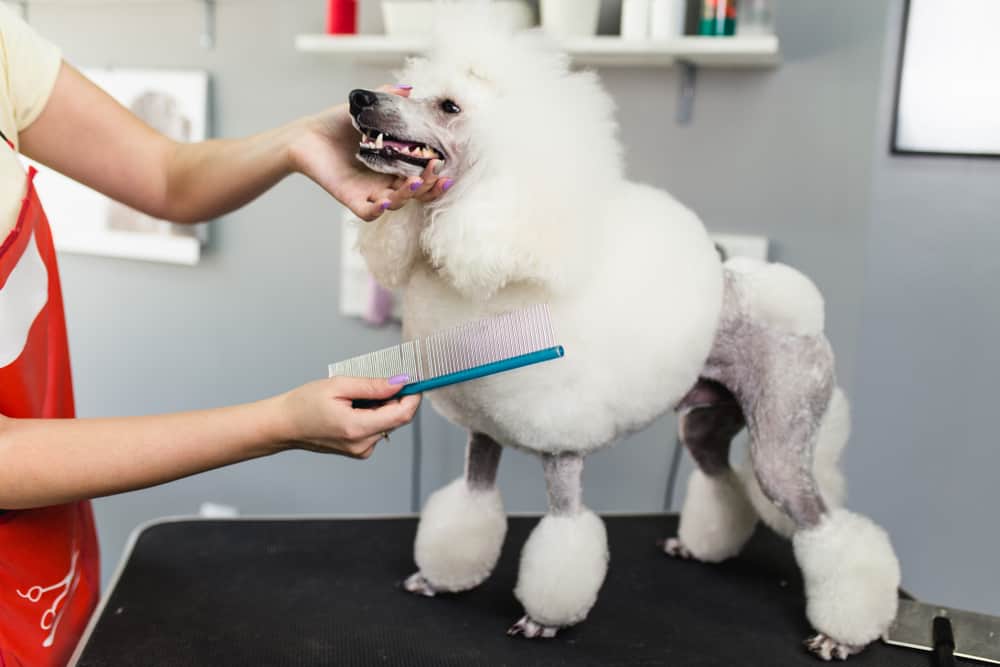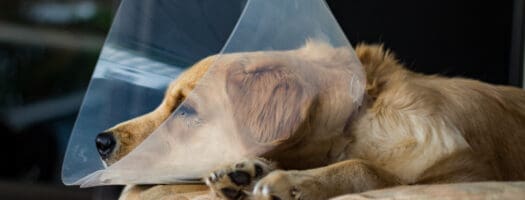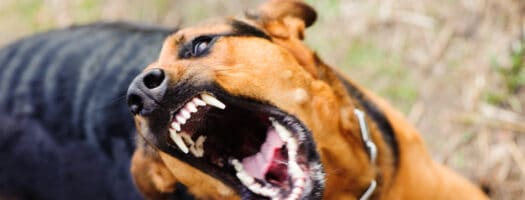How Much Should I Tip My Dog Groomer?

Whether your best friend is a fluffy-coated Pomeranian or a digging-prone Dachshund, most dog owners from time to time will need help with grooming their dogs. People usually prefer to visit the same groomer regularly once they find someone they like, but it can be awkward when it comes time to pay the bill.
That’s because like any other type of service industry, it’s customary to provide a tip in addition to the cost of the bill for those who perform grooming services. However, there isn’t a hard-and-fast rule with tipping dog groomers the way there is with restaurant servers (you’re tipping at least 20%, right?).
Several factors can influence what is considered an appropriate tip, and in some cases, you may not need to tip at all. We’ll cover all the details for you, and then take a closer look at the benefits of dog grooming, which breeds need it most, and the overall cost you can expect.
How Much to Tip Your Dog Groomer
In the U.S., it’s customary to tip in most cases when being provided a service. However, there are many exceptions to this, and even for people who do tip their groomers, there isn’t a single method of calculating how much extra to give. Thankfully, there are several considerations that can make this easier to determine.
Factors That Impact How Much Your Dog Groomer Should Be Tipped
Here are a few aspects to consider when deciding how much to tip your dog groomer.
What Service Did They Provide?
What did the groomer do? Did your dog receive a full service that included a bath, brushing, and all the rest? What about add-ons like a haircut, nail polish, or other pampering?
Of course, the standard price you’re charged takes into account all the services your dog received, but if your dog is very small or very large, or has a particular personality that makes grooming a challenge, it’s best to show your appreciation for the care and time taken with a few extra bucks.
How Much Time Did They Spend Grooming Your Dog?
Also, the time it takes to provide a full-service grooming experience varies by dog and not just because of their size or personality. The more detailed the cut, the more time the groomer will need to spend. A standard poodle who gets a puppy cut, in which the hair is close-cropped all over, is a much easier job than one whose hair is cut in the continental style, which is what you typically see at dog shows.
In short, the fanciness of the service should be reflected in the tip.
Did the Groomer Go Above and Beyond?
Let’s keep with our hypothetical of a dog that receives a full service, including bath, haircut, and more. In that scenario, let’s assume a base cost of $40 since our dog is small.
But now let’s assume the groomer has managed to squeeze you into a tight schedule, or say they stayed open later because you were caught in traffic and couldn’t get back in time. In that case, your tip should reflect not only the level of service they provided your dog but the accommodation they showed to you as well.
Does the Groomer Own the Business?
A standard etiquette rule indicates that it’s not proper to tip the owner of a business. Rather, the gratuity should go to an employee, ideally the one who physically provided your service. But what if they happen to be the same person?
If you’re a stickler for old-timey rules, feel free to skip the tip when you’re certain that the person providing the hands-on service is the same one whose name is on the sign. But keep in mind that even if they own the business, they may not make all that much money and may rely more on tipped income.
In fact, according to the U.S. Bureau of Labor Statistics, which reports employment data for thousands of jobs, dog groomers fall into a category called animal caretakers. The average animal caretaker in the U.S. makes just over $27,000 per year.
Not sure if the establishment accepts tips? Just ask them what their tipping policy is.
What Are Your Finances?
If you have the money to afford professional dog grooming, chances are you can also afford to tip the person pampering your pooch. But in situations where money is very tight, you may consider having the groomer provide less service, say, just a nail trim and brushing.
Or you could learn how to do most of these things yourself and save the professional grooming for a few times a year when you can save up enough to adequately reward the groomer.
Typical Dog Grooming Costs
Prices for dog grooming services vary depending on where you live, how large the grooming service is (chains tend to charge more), the extent of service required, the size of your dog, and more. But here’s a look at some typical cost ranges for the most popular grooming services:
- Full service: This typically includes a bath, brushing, haircut or trim, eye and ear cleaning or plucking, tooth brushing, and nail trimming or grinding. $40-$75, depending on size of dog.
- Nail trim: Cutting using clippers and/or nail grinder. Can include buffing. $10-$15 for trim, $15-$20 for trim and buff.
- Teeth brushing: Often includes full brushing and use of breath freshener, and sometimes freshener is extra. $10-$20.
- Ear cleaning: Rinsing ear canals with gentle cleanser, sometimes includes use of swabs or cotton balls inside ears. $10-$15.
- Anal gland expression: Usually includes squeezing glands and applying cologne. $10-$15.
Most groomers will provide bundles of services for better value. For example, if all your dog requires is her nails trimmed and anal glands expressed, a groomer may charge $20 total instead of asking you to pay the a la carte costs.
Other factors that can influence the cost of dog grooming services include:
- Weight: Many groomers base their standard full-service fees on the weight of the dog. A typical range is $25 for dogs weighing less than 14 pounds to $70 for dogs weighing upwards of 95 pounds.
- Breed: Dogs with more intense grooming needs will, of course, require more expensive services, even in dogs of similar size. For example, a short-haired breed like the corgi will usually be a more affordable dog to have professionally groomed than one of a similar size, like a cocker spaniel, because of the cocker’s curly fur.
- Special needs: While your groomer will happily accommodate a request like using a prescription shampoo or conditioner (assuming you provide it), they may charge you more if your dog is difficult to deal with or has physical limitations that make grooming difficult, even for a professional. Temperament is important to keep in mind, though most dogs become easier to deal with the more they have grooming sessions.
How Popular Is Dog Grooming?
Almost every dog owner has given their dog a bath (probably many baths), and lots of us have even gotten into a regular habit of trimming our dogs’ nails, cleaning ears, or giving haircuts. But some breeds have more difficult grooming needs, and there are other grooming tasks (yep, anal glands) that pet owners simply may not wish to deal with.
According to a recent study by the American Pet Products Association (APPA), pet owners spend about $96 billion annually on our pets. The association estimates that about $10 billion of that is devoted to services like grooming, boarding, and training.
APPA estimates that the average dog owner spends $73 per year on grooming services, though that figure includes buying grooming tools. Still, the average dog parent spends more on grooming than they do on vitamins or toys — and nearly as much as they spend on treats.
Benefits of Dog Grooming
Creating a cute hairdo is hardly the biggest benefit of establishing a grooming routine for your dog. In addition to regular at-home brushing and bathing, there are several other benefits of taking your dog to a professional groomer:
Ensuring Nails Are Kept at a Good Length
Overgrown nails are not only noisy on hard surfaces, but they can damage your dog’s foot and leg bones, reduce traction, leading to slips and falls, and cause injury to tendons. Additionally, dogs with long nails can hurt themselves by getting their nails caught on everything from rocks and sticks to blankets and rugs.
Preventing Ear Infections
Many grooming packages include flushing and cleaning ears, which is especially helpful for dogs with long, droopy ears, as they are prone to bacterial infections in their ear canals. Regular grooming can help ensure the conditions of an infection are avoided.
If your dog gets upset visiting the vet or being around strangers, he’ll probably have that same reaction the first time he gets groomed. But the more frequently you go, the more used to it he will become. Many dogs eventually enjoy visiting the groomer, especially if they get haircuts that make them feel more comfortable.
Catching Health Concerns Early
If they’re healthy, most dogs visit the veterinarian only once a year to get their annual shots and have a checkup. That means health problems that develop may not be noticed for a full year if it’s an issue you happen not to come across.
But the process of grooming, which usually includes a bath, brushing, and hair trimming, means that the groomer will be laying their hands on just about every area of your dog’s body and can let you know if they feel anything new or that they hadn’t felt before.
Additionally, regular visits to the groomer can prevent your dog’s anal glands from becoming full or getting impacted, which is not a pleasant experience for you or your dog.
Maintaining Dental Health
Some dog groomers provide dental cleanings as well, which can help stave off major tooth issues in dogs.

Dog Breeds That Benefit Most From Grooming
Dogs don’t all have the same type of fur, and depending on their dominant breed, they may require more regular grooming than a dog from another breed. Here’s a look at breeds that need the most regular grooming and why it may be difficult for the average owner to accomplish on their own.
Poodles
One of the most obvious breeds that need regular grooming, the familiar curly appearance of the poodle comes from hair, not fur. Unlike most other dogs, poodles’ coats will grow until they are cut. That means that if they’re left to grow without being trimmed back, the hair can become matted, which can lead to serious medical issues like lesions and flea infestations.
Other curly-haired, non-shedding dogs that need regular grooming include the bichon frisé and Portuguese water dog, but poodle hybrids like goldendoodles and labradoodles, while low-shedding dogs, aren’t prone to matting like their poodle progenitors.
Yorkshire Terrier
Like poodles, Yorkies have hair that will keep growing if left alone. In fact, Yorkies who are part of the dog show circuit will typically have hair that’s longer than they are.
Because their hair is straight, it’s less prone to matting, but even non-show Yorkies will require maintenance of their hair. Many Yorkie owners opt for the puppy cut, which keeps the hair on their bodies, heads, and ears closely cropped.
Siberian Husky/Alaskan Malamute
These two breeds are similar in look and lineage, but another major thing they have in common is that they are prodigious shedders. In both cases, these dogs shed moderate amounts of hair every day, and twice a year, they drop copious tufts in a period known as coat blowing.
Thorough professional brushing can help reduce shedding, though it’ll never stop it entirely, and unlike other dogs on this list, their hair doesn’t need to be cut.
The Bottom Line
There’s no passage in Emily Post to tell us exactly what to tip a dog groomer, and tipping expectations vary by industry and era. A few decades ago, a 10% tip in a restaurant was considered standard; today, that would probably get you some withering glances — at best.
When it comes to dog grooming, it’s reasonable to establish some standards for yourself, say, $5 for simple services like nail trimming and $10 or more for something closer to a full service. Providing a generous tip every time can help you rest assured that your dog is being well taken care of.




